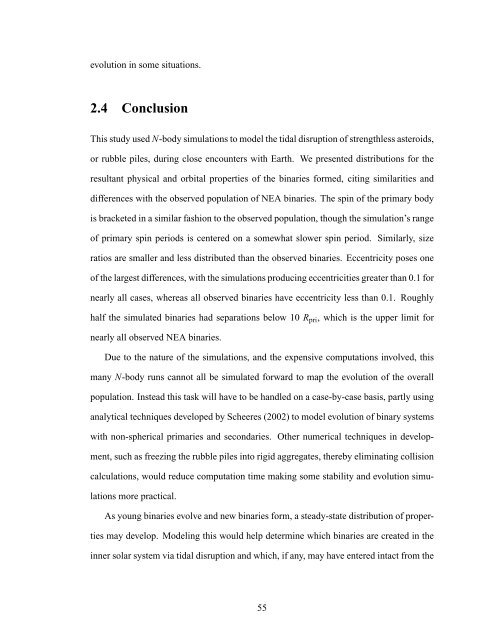Forming Binary Near-Earth Asteroids From Tidal Disruptions
Forming Binary Near-Earth Asteroids From Tidal Disruptions
Forming Binary Near-Earth Asteroids From Tidal Disruptions
You also want an ePaper? Increase the reach of your titles
YUMPU automatically turns print PDFs into web optimized ePapers that Google loves.
evolution in some situations.2.4 ConclusionThis study used N-body simulations to model the tidal disruption of strengthless asteroids,or rubble piles, during close encounters with <strong>Earth</strong>. We presented distributions for theresultant physical and orbital properties of the binaries formed, citing similarities anddifferences with the observed population of NEA binaries. The spin of the primary bodyis bracketed in a similar fashion to the observed population, though the simulation’s rangeof primary spin periods is centered on a somewhat slower spin period. Similarly, sizeratios are smaller and less distributed than the observed binaries. Eccentricity poses oneof the largest differences, with the simulations producing eccentricities greater than 0.1 fornearly all cases, whereas all observed binaries have eccentricity less than 0.1. Roughlyhalf the simulated binaries had separations below 10 R pri , which is the upper limit fornearly all observed NEA binaries.Due to the nature of the simulations, and the expensive computations involved, thismany N-body runs cannot all be simulated forward to map the evolution of the overallpopulation. Instead this task will have to be handled on a case-by-case basis, partly usinganalytical techniques developed by Scheeres (2002) to model evolution of binary systemswith non-spherical primaries and secondaries. Other numerical techniques in development,such as freezing the rubble piles into rigid aggregates, thereby eliminating collisioncalculations, would reduce computation time making some stability and evolution simulationsmore practical.As young binaries evolve and new binaries form, a steady-state distribution of propertiesmay develop. Modeling this would help determine which binaries are created in theinner solar system via tidal disruption and which, if any, may have entered intact from the55












